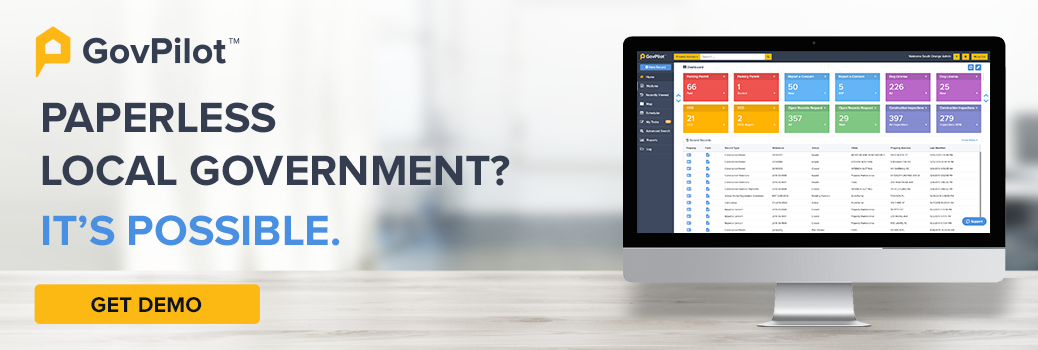Traditionally bound by paper-heavy processes and energy-intensive practices, municipal operations have contributed to environmental degradation for a long time.
From mountains of paper used for record-keeping to inefficient lighting and outdated technology systems that consume more power than necessary, these practices drain resources and leave a significant carbon footprint.
As the pressure for local governments to reassess operational methods becomes increasingly evident, reducing waste and energy consumption is no longer just an environmental consideration—it has become a core responsibility for municipalities that aim to lead by example.
The most promising avenue for creating more sustainable municipal operations is the adoption of eco-friendly software solutions - digital tools that streamline communication through cloud-based platforms and electronic document management systems.
By replacing outdated systems with technology that reduces both physical waste and energy consumption, your local government can take significant steps toward lowering its carbon footprint while enhancing operational efficiency.
As communities continue to demand greener policies, eco-friendly technology offers a clear path forward for local governments to balance sustainability with public service delivery.
Table of Contents: What To Expect
- Overview of the environmental challenges in municipal operations
- Explanation of eco-friendly software solutions.
- Benefits of reducing carbon footprints
- Examples of municipalities implementing green technology
- Steps for adopting eco-friendly software
The Environmental Challenges Faced in Municipal Operations
Municipal operations also bring forth complications with environmental factors that need to be accounted for. Read on to learn about some of the most common pain points and challenges:
-
Resource Consumption
The environmental challenge of managing resource consumption in municipal offices is rooted in the long-standing reliance on traditional, resource-intensive practices. Daily operations often rely on paper-heavy documentation, excessive printing, and outdated energy systems that lack efficiency.
Despite the growing availability of digital alternatives, many municipalities still cling to paper-based systems due to habit, regulatory requirements, or lack of digital infrastructure.
Learn all about The Benefits & Capabilities of Digital Transformation For Local Governments.
-
Waste Production
Waste production in municipal offices is largely driven by inefficient practices in paper use, outdated equipment disposal, and the overconsumption of single-use materials. Beyond paper waste, municipal offices frequently discard outdated electronic equipment, such as computers, printers, and other technology, without proper e-waste recycling protocols.
These devices contain hazardous materials, including heavy metals and toxic chemicals, which can leach into the environment when improperly disposed of, contaminating soil and water sources. In addition to paper and energy waste, many offices still rely on single-use plastics, from disposable cups to packaging, exacerbating waste production.
-
Sustainability Goals
The increasing pressure on municipalities to meet environmental standards can be a complex challenge for local government officials, as it requires a fundamental shift in both mindset and operations. Municipalities are often constrained by budget limitations, outdated infrastructure, and entrenched bureaucratic processes, making the adoption of green initiatives a daunting task.
While sustainability targets—reducing energy consumption, minimizing waste, and transitioning to renewable resources—are increasingly prioritized, many offices struggle to implement these goals due to a lack of cohesive planning and the necessary technological infrastructure.
Read all about our Local Government Sustainability Guide.
The Basics of Eco-Friendly Software Solutions
In this section, we get into the details of eco-friendly software solutions and the basic information you should know!
-
Digital Document Management
Eco-friendly government software solutions enable the creation, storage, and retrieval of documents in a fully electronic format, eliminating the need for printing, filing, and physically archiving vast amounts of paperwork.
With digital workflows, documents can be easily shared, signed, and approved electronically, bypassing the traditional reliance on hard copies for administrative processes such as permit applications, contracts, and internal communications. Digital document management systems offer robust tools for organizing and accessing information more efficiently than paper-based methods.
Check out GovPilot’s Workflow Automation For Governments here!
-
Energy-Efficient Systems
Sustainable technology for local governments optimize energy use in the office by integrating energy-efficient systems that monitor, regulate, and reduce power consumption across various operations. These solutions often come in the form of smart building management systems with auto-adjusting sensors and air conditioning (HVAC) systems based on real-time occupancy and environmental conditions.
By automatically dimming lights and adjusting the temperature of unoccupied spaces, these systems minimize unnecessary energy consumption, reducing your municipal carbon footprint. Energy-efficient systems can even provide detailed analytics on electricity use, identifying patterns of overconsumption and areas where further efficiency measures can be implemented.
-
Cloud-Based Solutions
On-site servers and data centers require substantial energy to operate, cool, and maintain, consuming large amounts of electricity while generating considerable heat, necessitating energy-intensive cooling systems to prevent overheating.
Cloud-based solutions eliminate the need for these local servers by moving data storage, computing, and software applications to off-site, more energy-efficient data centers managed by third-party providers.
Cloud providers typically optimize their operations by utilizing cutting-edge energy management technologies, including renewable energy sources, advanced cooling systems, and highly efficient server architectures, which dramatically reduce the overall carbon footprint of computing services.
A Deeper Understanding: Key Environmental Benefits
Dive into the key environmental benefits of eco-friendly software solutions and learn a bit more about how they can be applied in your municipality:
1. Reduction in Paper Waste
One of the most effective ways to reduce paper waste in municipal offices is by digitizing processes that traditionally rely on physical documents, including form submissions, approvals, and signatures. This optimization is achieved through the use of e-signatures and digital forms, which eliminate the need for printing, scanning, and storing paper copies.
Instead of printing out forms for permit applications, government contracts, or internal memos, these documents can be created, filled out, and signed entirely online, streamlining the workflow while cutting down on paper consumption.
E-signature platforms allow municipal employees, contractors, and citizens to securely sign documents from any location saving time and reducing the environmental impact associated with transportation and document duplication.
Digital forms are similarly transformative, enabling citizens to submit applications or requests directly through online portals, where information is automatically processed and stored electronically.
Learn everything about Do’s and Don'ts of Local Government Environmental Impact here!
2. Optimized Energy Use
Sustainable solutions for local government offices optimize energy use by using smart technologies that automate and control lighting, heating, ventilation, and air conditioning (HVAC) systems based on real-time data.
Green software solutions optimize energy use by integrating advanced energy management systems that enhance operational efficiency while reducing power consumption. Smart devices like motion sensors and occupancy detectors can adjust lighting levels or switch off unused equipment in empty rooms, ensuring that energy is not wasted when areas are unoccupied.
Similarly, HVAC systems can be programmed to adjust temperatures based on the number of people in a room, weather conditions, or time of day, reducing unnecessary energy use.
Energy management platforms provided by eco-friendly software often offer comprehensive data on energy consumption patterns within municipal buildings. This data enables local governments to identify inefficiencies and make informed decisions about where to implement energy-saving upgrades.
With GovPilot’s eco-friendly government software, Atlantic City’s government was able to achieve substantial energy savings through faster reporting, digital payment options, and doubled productivity.
Learn more about Why San Francisco Was Voted No. 1 Overall on Clean Energy Survey!
3. Lower Carbon Emissions
One of the most significant contributions toward minimizing the environmental impact of municipal activities is the reduction of travel-related emissions through the promotion of remote work and virtual meetings.
Traditionally, municipal employees and constituents have relied on commuting and in-person meetings to conduct business. This contributes to higher carbon emissions from vehicle use, especially in large government organizations with sprawling jurisdictions.
By enabling remote work, eco-friendly software platforms allow employees to perform their tasks from home or decentralized locations, cutting down on the need for daily commutes and reducing their municipal carbon footprint.
Become an expert on Preparing for The Impact of Climate Change here!
Addressing Pain Points: Transitioning to Eco-Friendly Software
Before you transition to the superior, eco-friendly software solutions, it is important to be informed about the commonly-experienced challenges of users. For an overview of the challenges and their effects, read on:
-
Initial Investment
For municipalities operating with constrained budgets or dealing with legacy systems that are deeply entrenched in daily operations, the initial investment to transition to eco-friendly software can be a concern. Upgrading to new digital platforms, implementing cloud-based infrastructure, and training staff on the use of eco-friendly technologies all require upfront financial and human resource commitments. While the initial outlay can be substantial, the long-term savings and benefits far outweigh the initial costs.
Eco-friendly software not only reduces the cost of paper-based supplies and energy but also lowers operational expenses over time by streamlining processes, improving efficiency, and reducing the need for physical infrastructure and maintenance.
Over time, these savings—combined with reductions in utility costs, waste management expenses, and the potential for government grants or incentives supporting sustainability initiatives—will offset the upfront costs.
Learn the differences between Custom vs. Off-the-Shelf: Software Solutions here!
-
Staff Training
Staff training is a common 'pain point' when transitioning to eco-friendly software, as it requires both time and resources. Many municipal staff members may be accustomed to traditional paper-based processes or legacy technologies, and the shift to modern, eco-friendly platforms can initially be met with resistance or apprehension.
The learning curve associated with these new tools can slow productivity during the early stages of implementation, adding to the perception that the transition is disruptive.
Thorough and well-structured training programs help to ensure employees are fully equipped to use new digital systems effectively. Tailored workshops, ongoing support, and hands-on training modules can help staff gradually acclimate to the new systems, ensuring they feel confident and competent in their use.
-
Compliance and Standards
When transitioning to eco-friendly software, municipal governments must navigate a complex landscape of compliance standards and sustainability benchmarks. Local, state, and national regulations often dictate specific requirements for energy efficiency, data security, waste reduction, and carbon reporting, all of which can complicate the adoption of new software systems.
Aligning with these regulations and pursuing certifications is not only necessary for legal compliance but also beneficial for the long-term sustainability and credibility of municipal operations.
Eco-friendly software solutions can actually simplify the compliance process by offering built-in tools that track energy consumption, monitor environmental impact, and generate reports that meet regulatory requirements. Many of these platforms are designed to help organizations seamlessly integrate sustainable practices into their workflows, making it easier to meet stringent environmental standards while also improving operational efficiency.
Invest Into Eco-Friendly Software Solutions
The digital transition to eco-friendly software enhances operational efficiency while contributing to environmental preservation and financial savings in government offices. The benefits of green software solutions translate into tangible cost reductions over time, making eco-friendly software not just a green choice, but a financially sound investment for your municipality's future.
As a leader in sustainable technology dedicated to empowering local governments, GovPilot's innovative solutions are designed to streamline operations while prioritizing environmental responsibility. Book a consultation with GovPilot today to learn how we can help.
Eco-Friendly Software FAQs
-
What are the most effective eco-friendly software solutions for municipalities?
Some of the most effective eco-friendly software solutions for municipalities include digital document management and cloud-based storage solutions.
-
How can digital transformation contribute to sustainability in local government?
Eco-friendly government software optimizes workflows and reduces excessive paper usage creating a more sustainable environment and community.
Read on:
- Actionable Tips for City Administrators
- Local Code Enforcement Technology & Workflows
- Modern Fleet Management Workflows for Local Governments
- How Counties & Municipalities Can Drive Local Economic Development
- How Local Governments Benefit From Broadband Internet
- What to Look for in Government Procurement Technology
- Government IT Strategy: How to Modernize IT Ticketing







